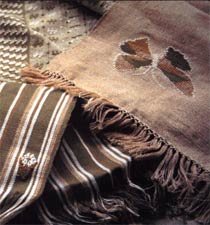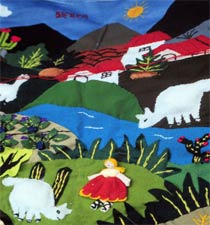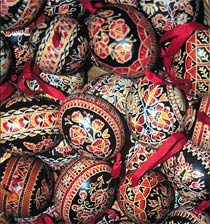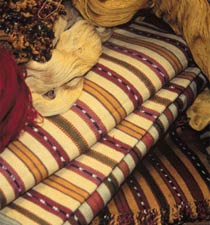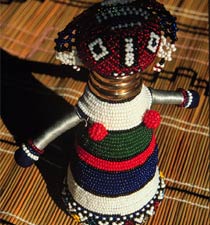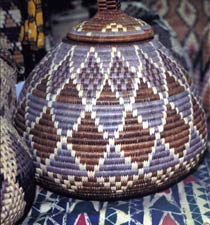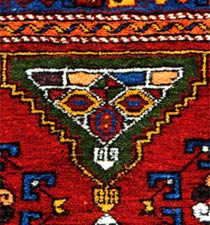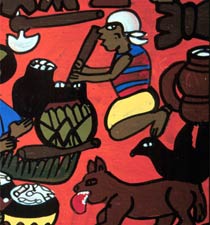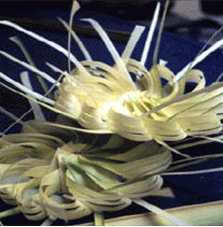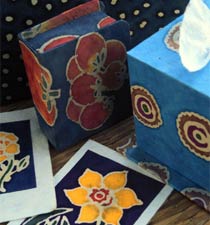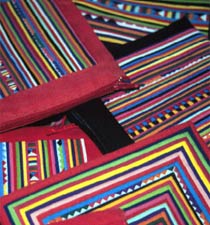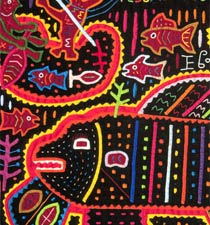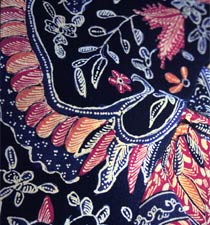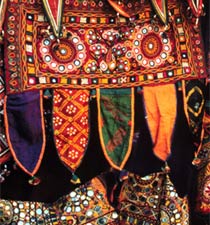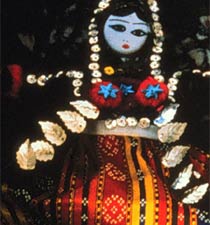|
Peru - Shipibo Pottery
Women
in the Indigenous Shipibo ethnic group, who live in the Pucallpa area of
Peru's Amazon Basin, are known for their pottery, which is covered with
webs of geometric lines. The pots are made by kneading tree ash into lake
or river mud, coiling the clay into shape, scraping the surface smooth with
pumpkin rind, painting and glazing, firing the pots on open bonfires, and
burnishing the surface with smooth stones.
|
| |
|
|
Bolivia - Knitted Dolls
Quechua women in Bolivia used to knit neutral-colored doll-shaped purses,
which they wore dangling from their belts. In 1968, a Peace Corps volunteer
encouraged them to substitute bright yarn colors and market the doll purses.
A female doll, whose dress is a money pouch, is always paired with a male
doll; every doll couple is unique in pattern and color.
|
| |
|
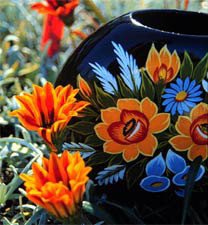 \ |
Poland - Floral Painting
In southeastern Poland, floral painting began in the 1800's when village
women brightened the sooty walls of their two-room cottages with white lime
dots that ultimately evolved into flowers. Today, the women decorate their
houses inside and out with floral designs. For the past fifty years, local
flower artists have competed in annual, juried competitions. In 1977, they
opened the House of Painters in Zalipie where the artists work and sell
vases, bells and other blossom-bedecked ceramic gifts.
|
| |
|
|
Guatemala - Cuyuscate Weaving
Cuyuscate, colored cotton that is native to Guatemala, grows in tones
of grey, pale green, and brown. It was used by ancient Mayan weavers but
has not been grown commercially until now. In an effort to revitalize the
weaving and embroidery markets, the Ixchel Museum in Guatemala City selected
the most talented craftswomen in the country's highlands to use cuyuscate
thread to create pillow covers, placemats, bookmarks and other home accessories.
|
| |
|
|
Peru - Arpilleras
Many
Peruvian women who live in the squatter communities that surround Lima,
learned to make arpilleras, three-dimensional appliquéd scenes, from an
art teacher who brought the craft from Chile where it originated. Although
arpilleras are made of fine-weave cotton, the word itself means "hopsacking"
or "burlap." When peasant refugees from Peru's recent Shining Path violence
sought sanctuary in Lima, the women began creating for sale, arpilleras
showing the country villages they left behind.
|
| |
|
|
Czech Republic - Kraslice
Vnorovy, a town in the Czech Republic, is unique in the world: for the
past hundred years, at least one woman in every house has created kraslice,
hand-painted Easter Eggs. These women pioneered the batik technique for
coloring eggs, using beeswax as the resist. Their signature designs - white,
yellow, red and black geometric and floral patterns - are each as unique
as snowflakes.
|
| |
|
|
Guatemala - Backstrap Weaving
In the Chimaltenango area of Guatemala, 450 widows of the thirty-six
year civil war that ended in 1996 still support their families. They weave
traditional local patterns into tablecloths, placemats and napkins, using
subtle-hued, colorfast yarns selected to appeal to a sophisticated consumer
market. Mayans believe the Goddess Ixchel created weaving; illustrated native
manuscripts show her using the same backstrap loom the weavers use today:
its continuous warp anchored by bars at each end, with one attached to a
belt that encircles her waist; the other, attached to a wall or tree.
|
| |
|
|
South Africa - Ndebele Beadwork
During the Boer war in the late nineteenth century, South African Ndebele
women in the Eastern Transvaal reacted against efforts to decimate the group's
distinctive character by resurrecting the beadwork that their foremothers
began creating three hundred years earlier. Beadwork is now central to Ndebele
personal, cultural and political identity as well as history, rituals -
and commerce. Today, the Ndebele bead women of Waterval make and market
dolls, trivets, mats and jewelry.
|
| |
|
|
South Africa - Zulu Baskets & Mats
Forty-five botanical species of reeds, rushes, palms and grasses grow
in KwaZulu near Durban, South Africa. This proliferation provides easily
available raw materials for products that range from museum-quality beer
baskets (isichumo) woven from Ilala palm - to simple mats made to sit on
(isicephu) or sleep on (icansi) woven from Ncema grass.
|
| |
|
|
Turkey - DOBAG Rugs
When
synthetic dyes caused the beautiful rugs created on the Aegean side of Turkey
to run and fade, the market deteriorated dramatically. In 1981, The University
of Marmara began DOBAG, a natural dye project that retrained weavers to
use madder root, onionskin, oak galls and chamomile dyes to create harmonious,
stable colors. Today, the cooperative includes four hundred families in
nineteen villages; the quality of all rugs produced by member weavers is
guaranteed for 200 years.
|
| |
|
|
Zimbabwe - Weya Art
In
the mid-1980's, Shona women from Weya, a commercial area in eastern Zimbabwe,
learned from Ilse Noy, a German art teacher, to create pictures of their
villages, lives and myths. Their work, rendered in oil paint, appliqué and
batik (for which readily affordable cornmeal porridge is the resist), has
been shown at the National Gallery in the country's capital.
|
| |
|
|
Indonesia - Floral Offerings
Every day on the Hindu island of Bali, Indonesia, women put offerings
in high places to petition the heavenly gods and in low places to placate
the demons. Materials for offerings come from the earth (flowers, leaves,
fruit, grain, fowl) and are transformed by cooking, cutting, mixing and
assembling, which every Balinese woman used to do at home. Today, women
with jobs have little time to make canang (daily offerings), so they buy
them in the market from one of the Brahmin, priest caste, women whose spirit
suffuses the offerings and becomes part of the gift to the gods.
|
| |
|
|
Thailand - Batiked Mulberry-Paper Gifts
Northern Thailand used to be the center of handmade papermaking. Now
that skill has been revived and Women Against AIDS has taught AIDS patients,
sex workers, and village women to create gift boxes, cards, folders and
picture frames, all covered with batik-patterned, handmade sa (mulberry)
paper.
|
| |
|
|
Thailand - Hill Tribe Needlework
Lisu and the Hmong women in the rural Chiang Mai area of northern Thailand
are experts at the embroidery and appliqué used to make placemats, purses,
book covers and household accessories. Some women learned these skills in
their native countries, China and Laos, but others just mastered them. King
Bhumibal Adulyadej's appliqué and silversmith skill classes help northern
farm families replace opium revenue (growing has been outlawed) and Queen
Sirikit's SUPPORT program helps others supplement the income from crops
that are harvested only annually.
|
| |
|
|
Panama - Molas
Molas - intricate, layered, appliquéd pictures showing contemporary life,
recent history and popular culture - form the front and back panels of the
blouses that Kuna Indian women wear in the San Blas Archipelago off the
east coast of Panama. Molas begin with reverse appliqué technique: stacked
fabrics are slashed and colors in the lower layers are pulled to the surface;
after they are sewn in place, more colors are stitched on top using traditional
appliqué techniques. Kunas credit their ancestress, Kicadiray, with creating
their women's colorful clothing, including Molas. Molas are sold as pillow
covers, place mats and framed art.
|
| |
|
|
Guatemala - Cuyuscate Weaving
Cuyuscate, colored cotton that is native to Guatemala, grows in tones
of grey, pale green, and brown. It was used by ancient Mayan weavers but
has not been grown commercially until now. In an effort to revitalize the
weaving and embroidery markets, the Ixchel Museum in Guatemala City selected
the most talented craftswomen in the country's highlands to use cuyuscate
thread to create pillow covers, placemats, bookmarks and other home accessories.
|
| |
|
|
Indonesia - Royal Batik
In the nineteenth century, only women at the seven royal courts in Central
Java created the intricate, ceremonial tulis, (hand-drawn), batik patterns
that sometimes required twenty-seven immersions in natural dyes. When the
monarchies were dismantled in 1922, the Kings' descendants began to sell
their work. Now many of these talented courtesans have died, but some have
launched The Pioneers, a foundation to teach, and hence perpetuate, the
endangered classic art of royal batik.
|
| |
|
|
India - Mirror Embroidery
Gujarat, India is one of the richest sources of folk embroidery in the
world. Mothers begin when their daughters are born to create mirror embroidery
for dowries that will include glittery wedding clothes for the bride and
groom, household lines, and camel finery. The Self Employed Women's Association,
a unique women's trade union, works with the Jat, Sodha, Ahir and Rabari
tribes in the Kachchh district and markets their mirror embroidered fashion
and home accessories.
|
| |
|
|
Turkey - Soganli Dolls
The
women make all the money in Soganli, Turkey, where fifty women in fifty
houses create dolls dressed in bright, silky costumes accented with sequins
- much like the clothes they wear themselves. The doll industry began in
the 1960's when Hanife Ablak made a doll for her daughter, Dondu, to take
to school for "show and tell." The women's doll market, which fills the
town plaza, is a convenient stop for tourists visiting Cappadocia.
|
|

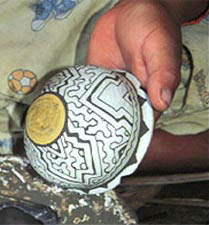
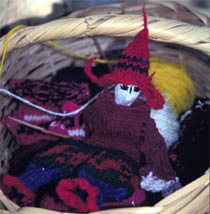
 \
\